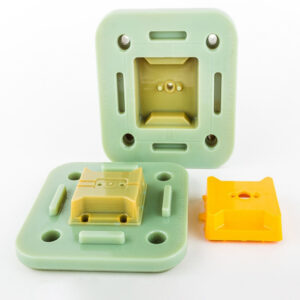
Vacuum casting, also known as silicone molding or polyurethane casting, is a manufacturing process used for creating multiple copies of a prototype or model. This technique is especially useful when producing small to medium-sized batches of parts with intricate details and high-quality surface finishes. Here are some common applications of vacuum casting:
Prototyping:
Product Development: Vacuum casting is widely used in the product development phase to create prototypes for testing and evaluation before mass production. It allows designers and engineers to iterate quickly and make necessary modifications.
Low-Volume Production:
Small-Batch Manufacturing: Vacuum casting is cost-effective for producing small quantities (typically up to a few hundred units) of parts. This is advantageous when traditional injection molding may be too expensive or time-consuming for low-volume production runs.
Customized Parts:
Medical Devices: Vacuum casting is often employed in the production of customized medical device components, such as prosthetics, orthopedic implants, and dental appliances.
Consumer Electronics:
Enclosures and Housings: Prototyping and producing small batches of casings or housings for electronic devices like smartphones, wearables, and remote controls.
Automotive Applications:
Interior Components: Vacuum casting is used to create interior components for vehicles, such as dashboard prototypes, gear shift knobs, and trim pieces.
Aerospace Components:
Prototyping and Testing: In aerospace engineering, vacuum casting is utilized to produce prototypes for testing and validating components before they go into mass production.
Art and Design:
Sculptures and Art Installations: Artists and designers often use vacuum casting to replicate their original sculptures or art pieces for exhibitions or commercial purposes.
Consumer Goods:
Toys and Collectibles: Manufacturers use vacuum casting for creating prototypes and small production runs of toys, action figures, and collectibles.
Industrial Components:
Functional Prototypes: Vacuum casting is employed to produce functional prototypes of industrial components, allowing engineers to assess the performance and durability of the parts.
Electronics Enclosures:
Handheld Devices: Vacuum casting is suitable for creating prototypes and small batches of casings for handheld electronic devices, such as remote controls, scanners, and industrial gadgets.
Architectural Models:
Scale Models: Architects and designers use vacuum casting to create scale models of buildings, landscapes, and urban environments for presentations and client approvals.
Vacuum casting offers advantages such as fast turnaround times, relatively low tooling costs, and the ability to produce high-quality parts with intricate details and textures, making it a versatile manufacturing technique for various applications.
Top of Form
